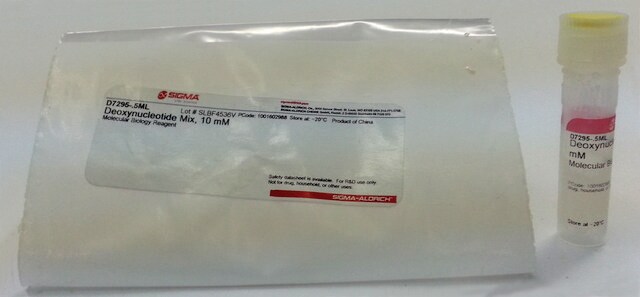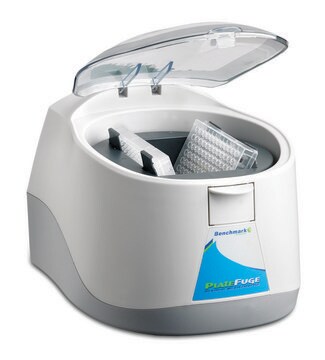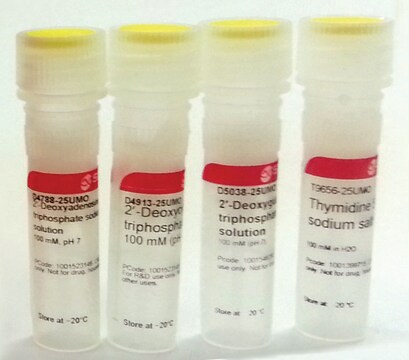2GRKB
Roche
KAPA2G Robust PCR Kit
Sinónimos:
PCR
About This Item
Productos recomendados
usage
sufficient for 200 reactions
sufficient for 500 reactions
Quality Level
shelf life
≤12 mo.
feature
Difficult Templates/Specialty Enzymes PCR
dNTPs included
hotstart: no
packaging
pkg of 100 U (KK5023)
pkg of 250 U (KK5024)
manufacturer/tradename
Roche
technique(s)
PCR: suitable
input
crude DNA
storage temp.
−20°C
¿Está buscando productos similares? Visita Guía de comparación de productos
General description
The enzyme is supplied with three reaction buffers, and a proprietary enhancer for GC-rich PCR. KAPA2G Buffer A is specifically formulated for the unique characteristics of the engineered KAPA2G enzymes, while KAPA2G Buffer B is recommended when template samples are contaminated with PCR inhibitors. KAPA2G GC Buffer is recommended for GC-rich PCR, while KAPA Enhancer 1, a proprietary DNA destabilizer, may be combined with either KAPA2G Buffer A or B in GC-rich assays, or assays where secondary structure is problematic.
Application
- Amplification of GC- or AT-rich templates and gene amplification
- Templates containing common PCR inhibitors e.g. salts, urea, SDS, or ethanol
- Crude sample PCR e.g. buccal swabs, cultured mammalian, yeast, or bacterial cells
- Colony PCR
- Routine PCR
- PCR amplification
- Avipoxvirus specific PCR
- Simplex PCR
- Semi-quantitative PCR
Biochem/physiol Actions
Features and Benefits
- Robust performance across a wide range of GC- and AT-rich templates
- Increased PCR success rates
Improved tolerance to common PCR inhibitors
- Efficient amplification from crude samples
- Higher yield and sensitivity per unit of enzyme
Unrivalled performance in colony PCR
- Higher yields and improved consistency of PCR direct from E. coli and yeast cells
Quick Notes:
- KAPA2G Robust PCR Kits contain KAPA2G Robust DNA Polymerase, engineered for high processivity and inhibitor tolerance.
- Both purified genomic DNA and crude samples (e.g. colony PCR) can be used as template.
- Use 0.5 U of KAPA2G Robust DNA Polymerase per 25 μL reaction. More challenging PCRs (GCrich,crude sample) may require higher enzyme concentrations.
- Use 15 sec/kb extension time per cycle, and increase to 30–60 sec/kb for difficult amplicons or templates.
- KAPA2G Buffers contain 1.5 mM MgCl2 at 1X.
- Additional MgCl2 may be added using the 25 mM MgCl2 solution provided in the kit.
- KAPA2G Buffer A is optimized for high yield, specificity, and sensitivity.
- KAPA2G Buffer B is recommended for inhibitorcontaminated template samples.
- KAPA2G GC Buffer is recommended for GC-rich PCR (>70% GC).
- KAPA Enhancer 1 can be used with KAPA2G Buffer A or B, particularly for GC-rich assays.
- Reaction products are 3′-dA-tailed and may be cloned into TA cloning vectors.
Quality
Preparation Note
Other Notes
Solo componentes del kit
- KAPA2G Robust Standard or HotStart® DNA Polymerase 5 U/μL
- 5X KAPA2G Buffer A with MgCl2
- 5X KAPA2G Buffer B with MgCl2
- 5X KAPA2G GC Buffer with MgCl2
- 5X KAPA Enhancer 1
- MgCl2 25 mM
signalword
Warning
hcodes
Hazard Classifications
Acute Tox. 4 Oral - Aquatic Chronic 3 - STOT SE 2
Storage Class
12 - Non Combustible Liquids
wgk_germany
WGK 1
flash_point_f
does not flash
flash_point_c
does not flash
Elija entre una de las versiones más recientes:
Certificados de análisis (COA)
¿No ve la versión correcta?
Si necesita una versión concreta, puede buscar un certificado específico por el número de lote.
¿Ya tiene este producto?
Encuentre la documentación para los productos que ha comprado recientemente en la Biblioteca de documentos.
Artículos
An overview of directed evolution and the methods for generating proteins with optimized or entirely new functions.
Nuestro equipo de científicos tiene experiencia en todas las áreas de investigación: Ciencias de la vida, Ciencia de los materiales, Síntesis química, Cromatografía, Analítica y muchas otras.
Póngase en contacto con el Servicio técnico








